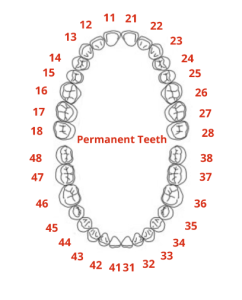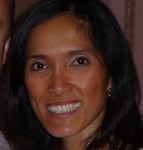Medically Reviewed By: Dr. Joanne Baldos, DDS
Teeth numbers can be confusing, especially since they vary from country to country. In this teeth numbers guide, we will discuss everything you need to know about your teeth numbers and the differences between permanent (adult) and primary (child) teeth.
Teeth Numbers: The Universal Number System
Teeth Numbering Chart (Adults)
In the US, the Universal Number System is used for numbering teeth. Each tooth is given a single number depending on its location in the mouth. All the teeth will be numbered from the patient’s perspective, i.e. first person.

Numbers 1-16 are located in the maxillary arch, your upper jaw. These numbers start from the top right, backmost tooth, of the mouth and go across the upper teeth to your top left, backmost tooth. Numbers 17-32 are located in your mandibular arch, your lower jaw. These numbers start from the bottom left, backmost tooth and go across to your bottom right, backmost tooth.
Teeth Numbers and Names (Adults)
Here is a list of all the teeth numbers and their corresponding names.
Upper Right Teeth
| Teeth Numbers | Teeth Names |
|---|---|
| 1 | Wisdom Tooth (3rd Molar) |
| 2 | Molar (2nd Molar) |
| 3 | Molar (1st Molar) |
| 4 | Bicuspid (2nd) |
| 5 | Bicuspid (1st) |
| 6 | Canine (Eye tooth / Cuspid) |
| 7 | Incisor (Lateral) |
| 8 | Incisor (Central) |
Upper Left Teeth
| Teeth Numbers | Teeth Names |
|---|---|
| 9 | Incisor (Central) |
| 10 | Incisor (Lateral) |
| 11 | Canine (Eye tooth / Cuspid) |
| 12 | Bicuspid (1st) |
| 13 | Bicuspid (2nd) |
| 14 | Molar (1st Molar) |
| 15 | Molar (2nd Molar) |
| 16 | Wisdom Tooth (3rd Molar) |
Lower Left Teeth
| Teeth Numbers | Teeth Names |
|---|---|
| 17 | Wisdom Tooth (3rd Molar) |
| 18 | Molar (2nd Molar) |
| 19 | Molar (1st Molar) |
| 20 | Bicuspid (2nd) |
| 21 | Bicuspid (1st) |
| 22 | Canine (Eye tooth / Cuspid) |
| 23 | Incisor (Lateral) |
| 24 | Incisor (Central) |
Lower Right Teeth
| Teeth Numbers | Teeth Names |
|---|---|
| 25 | Incisor (Central) |
| 26 | Incisor (Lateral) |
| 27 | Canine (Eye tooth / Cuspid) |
| 28 | Bicuspid (1st) |
| 29 | Bicuspid (2nd) |
| 30 | Molar (1st Molar) |
| 31 | Molar (2nd Molar) |
| 32 | Wisdom Tooth (3rd Molar) |
Teeth Numbering Chart (Children)
The teeth numbering system is slightly different for children. For primary teeth, which are baby teeth, the system uses letters A through T.

The way each tooth is given its letter is the exact same as adult teeth. The upper teeth (A-J) are given their letters from the top right, backmost tooth to the top left, backmost tooth. The mandibular teeth (K-T) are given their letters from the bottom left, backmost tooth to the bottom right, backmost tooth.
Teeth Numbers and Names (Children)
Here is a list of all the teeth numbers and their corresponding names.
Upper Right Teeth
| Teeth Numbers | Teeth Names |
|---|---|
| A | Molar (2nd Molar) |
| B | Molar (1st Molar) |
| C | Canine (Eye tooth / Cuspid) |
| D | Incisor (Lateral) |
| E | Incisor (Central) |
Upper Left Teeth
| Teeth Numbers | Teeth Names |
|---|---|
| F | Incisor (Central) |
| G | Incisor (Lateral) |
| H | Canine (Eye tooth / Cuspid) |
| I | Molar (1st Molar) |
| J | Molar (2nd Molar) |
Lower Right Teeth
| Teeth Numbers | Teeth Names |
|---|---|
| K | Molar (2nd Molar) |
| L | Molar (1st Molar) |
| M | Canine (Eye tooth / Cuspid) |
| N | Incisor (Lateral) |
| O | Incisor (Central) |
Lower Left Teeth
| Teeth Numbers | Teeth Names |
|---|---|
| P | Incisor (Central) |
| Q | Incisor (Lateral) |
| R | Canine (Eye tooth / Cuspid) |
| S | Molar (1st Molar) |
| T | Molar (2nd Molar) |
How does the American Teeth Number System Compare to Teeth Numbers in Canada?
In Canada and the rest of the world, teeth are numbered using the FDI World Dental Federation notation. This international standard for dental numbers uses a different system with quadrants.
Each tooth is given two numbers to represent its location. The first number is the quadrant in which the tooth is located, and the second number represents the tooth’s position within that quadrant.
This means that each quadrant (upper left, upper right, lower left, lower right) is numbered separately. The teeth in each quadrant are then numbered from front to back, starting with the tooth closest to the midline of your face.
Teeth Quadrants
Teeth quadrants are given their names from the patient’s perspective. This means that each quadrant is given its name based on its location in relation to the patient’s view of themselves.
In adult teeth, the teeth quadrants are numbered as follows:
- Upper right quadrant (UR): Quadrant 1
- Upper left quadrant (UL): Quadrant 2
- Lower left quadrant (LL): Quadrant 3
- Lower right quadrant (LR): Quadrant 4
In baby teeth, also known as primary teeth, the teeth quadrants are numbered differently. The teeth in the primary dentition are:
- Upper right quadrant (UR): Quadrant 5
- Upper left quadrant (UL): Quadrant 6
- Lower left quadrant (LL): Quadrant 7
- Lower right quadrant (LR): Quadrant 8
Teeth Numbering

The teeth in each quadrant are then numbered from #1-8. The tooth numbers start at the center of the mouth and move towards the back.
Each number corresponds to a different type of tooth in the adult human body:
- Tooth 1: Central Incisors
- Tooth 2: Lateral Incisors
- Tooth 3: Canine (Cuspids)
- Tooth 4: First Premolar (First Bicuspid)
- Tooth 5: Second Premolar (Second Bicuspid)
- Tooth 6: First Molar
- Tooth 7: Second Molar
- Tooth 8: Third Molar (Wisdom Tooth)
In children’s teeth each number corresponds to the following:
- Tooth 1: Central Incisors
- Tooth 2: Lateral Incisors
- Tooth 3: Canine (Cuspids)
- Tooth 4: First Molar
- Tooth 5: Second Molar
For more information on the Canadian teeth numbering system click this link.
Disclaimer
The contents of this website, such as text, graphics, images, and other material are for informational purposes only and are not intended to be substituted for professional medical advice, diagnosis, or treatment. Nothing on this website constitutes the practice of medicine, law or any other regulated profession.
No two mouths are the same, and each oral situation is unique. As such, it isn’t possible to give comprehensive advice or diagnose oral conditions based on articles alone. The best way to ensure you’re getting the best dental care possible is to visit a dentist in person for an examination and consultation.
SAVE TIME AND MONEY AT ANY DENTIST

Less dental work is healthier for you. Learn what you can do to minimize the cost of dental procedures and avoid the dentist altogether!
About the Reviewer
Dr. Joanne Baldos is a 1998 graduate of the Doctor of Dental Surgery program at the University of Toronto. She finished first overall in her class and was awarded the Dean’s Gold Medal for the Highest Overall Academic and Clinical Achievement. Upon graduation, she was accepted to the highly sought after postgraduate general practice residency program at Toronto General Hospital where she received advanced training in multidisciplinary treatment. She currently practices at Smile Care Dental in Cambridge, Ontario.


